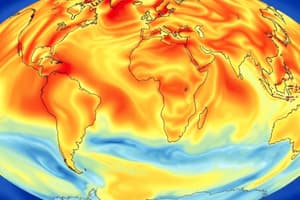Podcast
Questions and Answers
What do SST anomalies represent?
What do SST anomalies represent?
- The observed temperature for a specific location
- The departure of observed temperature from the average temperature
- The average temperature for a specific location
- The difference between observed temperature and average temperature divided by the standard deviation (correct)
How do SST anomalies impact agriculture?
How do SST anomalies impact agriculture?
- Causing no impact on agricultural practices
- Enhancing crop growth in semi-arid regions (correct)
- Decreasing evaporation and humidity patterns
- Improving agricultural productivity in all regions
In what regions is SST often visualized as a plateau?
In what regions is SST often visualized as a plateau?
- Equatorial regions
- Regions with high evaporation rates
- The North Atlantic subpolar gyre (correct)
- Coastal areas with heavy rainfall
Why are SST anomalies considered valuable indicators for scientists?
Why are SST anomalies considered valuable indicators for scientists?
What is essential for forecasting future climate patterns according to the text?
What is essential for forecasting future climate patterns according to the text?
How can warmer SSTs contribute to drought conditions affecting agriculture?
How can warmer SSTs contribute to drought conditions affecting agriculture?
What is the significance of Sea Surface Temperature (SST)?
What is the significance of Sea Surface Temperature (SST)?
How are SST changes primarily monitored?
How are SST changes primarily monitored?
What role does SST play in ocean circulation?
What role does SST play in ocean circulation?
How can warmer SSTs intensify ocean currents?
How can warmer SSTs intensify ocean currents?
What is a common method used to observe and monitor SST changes?
What is a common method used to observe and monitor SST changes?
How do warmer SSTs impact agriculture?
How do warmer SSTs impact agriculture?
Flashcards are hidden until you start studying
Study Notes
Sea Surface Temperature (SST) and Its Significance
Sea surface temperature (SST) refers to the temperature of the topmost layer of our planet's oceans. It's a crucial component in understanding climate patterns, ocean circulation, and the impact of these factors on our world. This article will delve into monitoring SST changes, its influence on ocean circulation, SST anomalies, and its implications for agriculture.
Monitoring SST Changes
SST regularly fluctuates due to natural processes, such as the El Niño Southern Oscillation, as well as human-induced global warming. Satellites and in-situ instruments like buoys are essential tools for observing and monitoring these changes. The U.S. National Oceanic and Atmospheric Administration (NOAA) and the European Space Agency (ESA) maintain several satellite systems dedicated to measuring SST, such as the Advanced Very High Resolution Radiometer (AVHRR) and the Advanced Microwave Scanning Radiometer (AMSR-E).
Ocean Circulation Influenced by SST
SST plays a central role in ocean circulation, which in turn impacts global climate patterns. Warm water rises, cools, and sinks, creating ocean currents such as the Gulf Stream and the Kuroshio Current. These currents disperse heat across the globe, moderating temperatures in various regions. Warmer SSTs can cause a positive feedback loop where warmer water leads to more rapid evaporation, further increasing SST and intensifying ocean currents.
SST Anomalies
SST anomalies are departures from the average SST for a specific location and time period. Anomalies are generally expressed as the difference between the observed temperature and the average temperature, divided by the standard deviation of the average temperature. Anomalies are valuable indicators of climatic variations and help scientists understand the natural variability of ocean temperatures and the effects of climate change.
Agriculture and SST
SST anomalies can have significant consequences for agriculture, particularly in coastal areas where they influence precipitation, evaporation, and humidity patterns. Warmer SSTs can result in increased atmospheric moisture, which could enhance precipitation and improve crop growth in semi-arid regions. Conversely, such anomalies can also contribute to drought conditions, impeding agricultural productivity.
Plateau
While SST is often considered as a two-dimensional surface, it can also be visualized as a three-dimensional field, with horizontal surface and vertical depth components. Some regions of the ocean, like the North Atlantic subpolar gyre, exhibit a plateau where the SST does not vary much with depth. These plateaus are critical in understanding the stability of the ocean and can be influenced by climate patterns and El Niño events.
Understanding SST and its associated changes, anomalies, and influences on ocean circulation is essential for forecasting future climate patterns, mitigating the risks of climate change, and improving global food security. Scientific progress in SST monitoring technologies and increased collaboration among researchers are vital to our ability to study and respond to these complex challenges.
Studying That Suits You
Use AI to generate personalized quizzes and flashcards to suit your learning preferences.




